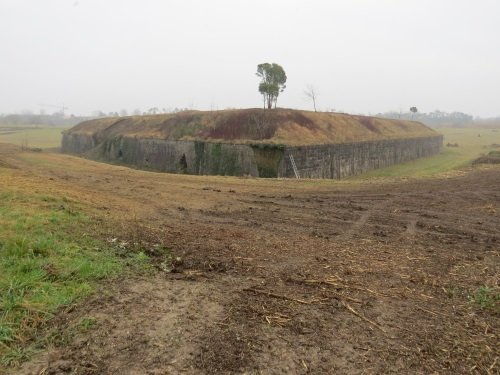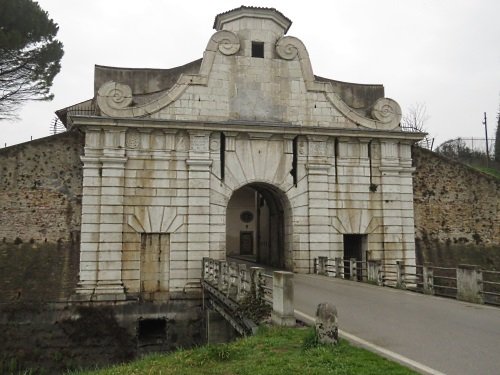Palmanova features twice on Italy’s current Tentative List: on its own as
Fortress Town of Palmanova
, ánd as part of
The Venetian Works of Defence
. The latter is a transnational serial nomination of fortifications in Italy, Croatia and Montenegro, which is scheduled for WH listing in 2017. The bid strategy seems to be using the already inscribed
Venice
and
Kotor
as virtual 'bookends', to be able to pull along a string of minor sites between them such as Zadar and this small town of Palmanova.

|
|
One of the 9 points of the star-shaped fortress
|
The fortress town of
Palmanova
was built by the Venetian Republic in 1593, in the shape of a nine-pointed star. These kind of star fortifications were fashionable in the late fifteenth and early sixteenth centuries primarily in response to the French invasion of the Italian peninsula. The French army was equipped with a new, more powerful cannon that was easily able to destroy traditional fortifications built in the Middle Ages. Palmanova certainly isn’t the only surviving star fortification: we have an ample
connection
for them already on this website. It is one of the early ones though.
Other reviewers
have found it hard to spend more than 30 minutes here. But especially on a bright day I found that there is enough to see and do for a ‘proper visit’ of at least 2 hours:
Admire the three city gates from both sides: they date from two different periods and vary enough in design to check them all out.
Circumnavigate the town via one of the ‘Nordic walking’ trails. These footpaths are between 4 and 6.3 km in length. Each is dedicated to one of the three phases of construction of the fortifications.
End up at the massive hexagonal central square. It looks made for a parade.
Visit the
Civic History Museum
or
Historical Military Museum
. The Military Museum has an outdoor part too. Be aware though of the limited opening hours of both museums.

|
|
Porta Aquileia
|
During my short trip to northeastern Italy late February I arrived in Palmanova by direct bus from Aquileia, some 40 minutes south. I got off just after entering the city gate, and walked back to the ramparts. Information panels show the trails that have been created here for mountainbikers and (Nordic) walkers. I took the inner route, which would take 50 minutes to fully complete. It was a very hazy day unfortunately, only the silhouettes of the fortifications were visible. I walked one third of the trail, and then entered the town again via another gate. Passing any of the three city gates on foot is a small adventure, as the entrance is only wide enough for one car and the traffic flows steadily. So the local authorities have installed traffic lights especially for pedestrians to safely overcome this hurdle.
I had a look around town and ate a pannini for lunch in a typical neighbourhood café, before walking to the railway station for the return trip. The station lies outside of the third gate, and next to an open field where one of the nine star points of the fort can be seen well. This I found the most interesting of the 3 possible approaches into Palmanova.

|
|
Loggia dei Mercanti
|
The creation of Palmanova was a bit of a failure, historically speaking. It was built
ex nihilo
by the Venetians, as an ideal city that would be lovely to live in. Unfortunately no volunteer citizens came forward, so the Venetians “pardoned a number of prisoners in 1622 and gave them property in Palmanova”. And although being a fortress, Palmanova never saw a battle. Despite its apparently impenetrable defense, Palmanova was captured twice – first by Napolean and then back by the Kingdom of Italy.



